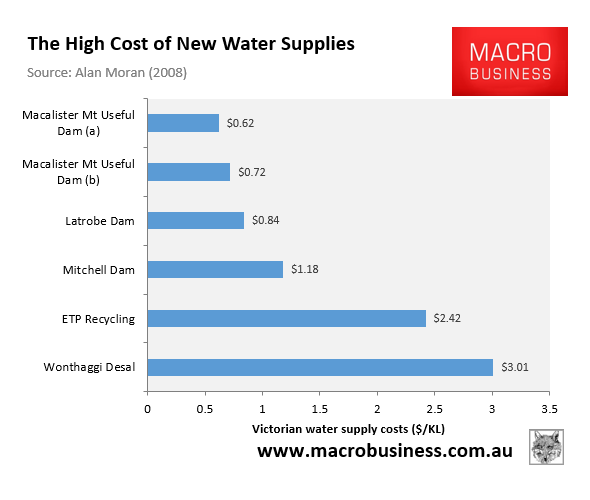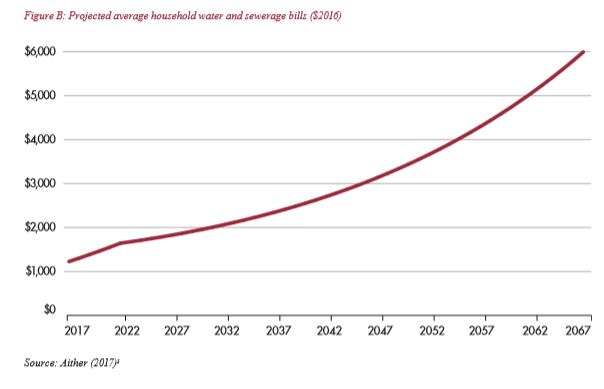This morning I gave an interview with Radio 2GB’s Luke Grant where I briefly discussed the latest monthly CPI inflation data and why interest rates should remain on hold.
We then had a detailed discussion on why Australia is facing dire water shortages owing to the upcoming drought, climate change, and the federal government’s Big Australia mass immigration policy.
This interview is part of The Treasury of Common Sense, which is a weekly segment on Radio 2GB on the Australian economy and policy.
Edited Transcript on Water Shortages:
Luke Grant:
We’ve been told to save water. Is that because of impending El Nino? Or they know something about, you know, the lack of dams?
Leith van Onselen:
So, Deloitte Access Economics released their weekly economic briefing last week. They basically said that Australians have got to learn to use less water to accommodate Australia’s aggressive population expansion – read immigration – as well as climate change, which is going to reduce rainfall.
So basically, what they’ve said is we’re going to have heaps more people coming to Australia and we’re also going to have less rainfall. So therefore, we have to get used to using a lot less water to accommodate the extra people.
My counter to that is: why are we growing the nation’s population like a science experiment when we live on the driest continent on Earth.
The last three years have obviously been pretty good on the rain front. We had a La Nina and the negative Indian Ocean Dipole. And what that meant was obviously – you know we all lived it – we got bombarded with rain for three years.
Unfortunately, we’ve got the reverse of that now. We’ve got El Nino and positive Indian Ocean Dipole. And basically, the Bureau of Meteorology tips an extremely dry and also hot spring and summer. And that’s probably going to last for a few years.
We’re going to have basically the reverse of what we had the last three years. And what this means is that in probably, you know, three or four years, we’re going to be looking at the similar situation to what we had four years ago before we had the bushfires.
We had very low water supply and obviously drought conditions across the country. Now, the difference is we’re going to have grown the population by potentially a couple million by then, which is a couple million more of mouths to provide water to. And this means you’re going to be in a worse situation.
The ultimate end game for this is if we keep doing what we’re doing, we’re going to keep building loads of water desalination plants across the nation, which are incredibly expensive.

Desalinated water costs about five times as much as dam water. And what this means is that they’re going to use a lot of energy because you’ve got to pump the water uphill.
So, if you live in Western Sydney 50 kms from the ocean, you’re going to have to pump that water uphill, which takes a hell of a lot of power.
Infrastructure Australia projected in 2017 that with all these desalination plants and climate change, household water bills are going to rise fourfold over 60 years. In real terms, $1226 was their figure in 2017 and that’s going to rise to $6000 in 2017 money.
That’s obviously going to be pretty hard if you’re a low income earner. You’re going to be paying a lot more for your water. Probably paying a lot more for your electricity and everything else as well to accommodate effectively this huge increase in the population that nobody really voted for or really wants.
It’s pretty stupid. Why are we growing the population so quickly in the driest continent on Earth when we don’t have enough water supply really to accommodate the current population?
There is a broader issue to work here, Luke. The 2021 State of the Environment Report, which is released by the federal government – done by a panel of environmental experts – they actually said in that report that population growth has a “very significant impact” on the environment.

It’s actually the biggest driver of environmental degradation. And yet every time they release this report, it gets ignored and we keep running these very high population growth policies.
They just say “Net Zero” and we can just forget about it. Yet, the State of the Environment report basically says that population growth impacts everything to do with the environment. And it has a very high impact.
You can see it here with the water supply. You can see it with everything else like land clearing and all the other stuff. And yet it’s always ignored. Nobody talks about it. And even the so-called environmental party – The Greens – don’t discuss it.
It’s a diabolical situation we’ve got. And it’s a bit like a slow motion car crash. You can see it coming. We’re going to have incredibly dry period and we’re going to have basically the same problem we had four years ago but potentially worse because we’re going to have millions more people, which makes the problem worse.


